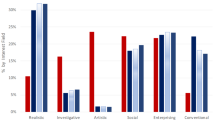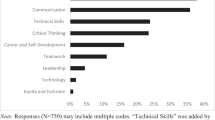Abstract
Using the data from the 2004 National Study of Postsecondary Faculty (NSOPF:04) survey, the study examined foreign-born women faculty members’ work roles and productivity in the areas of teaching, research, and service in comparison with their US-born counterparts at research universities in the US. The findings provided some evidence to suggest that foreign-born women faculty members’ patterns of engagement in work activities contradicted the gendered division of labor in academia. The findings indicated that foreign-born female academics were significantly more engaged in research that was evident in the number of scholarly outputs they produced compared to US-born women faculty colleagues. On the other hand, they seemed to be less involved in teaching and service functions of their work than their US-born women peers. The study could serve as a good starting point to further examine foreign-born women faculty socialization into faculty roles and their academic work culture.

Similar content being viewed by others

References
Acker, S., & Feuerverger, G. (1996). Doing good and feeling bad: The work of women university teachers. Cambridge Journal of Education, 26(3), 1–21.
Aguirre, A. Jr. (2000). Women and minority faculty in the academic workplace: Recruitment, retention, and academic culture. ASHE-ERIC Higher Education Report, 27(6). Washington: The George Washington University.
Allen, H. L. (1997). Faculty workload and productivity: Ethnic and gender disparities. The NEA 1997 Almanac of Higher Education, 25–42.
Altbach, P. G. (2005). Globalization and the university: Myths and realities in an unequal world. The NEA 2005 Almanac of Higher Education, 63–74.
Altbach, P. G. (2006). The internationalization of higher education: Motivations and realities. The NEA 2006 Almanac of Higher Education, 27–36.
Barbezat, D. A. (2002). History of pay equity studies. In R. K. Toutkoushian (Ed.), Conducting salary-equity studies: Alternative approaches to research. New Directions for Institutional Research, 115 (pp. 9–39). San Francisco: Jossey-Bass.
Bellas, M. L. (1999). Emotional labor in academia: The case of professors. ANNALS, AAPS, 561, 96–110.
Bellas, M. L., & Toutkoushian, R. K. (1999). Faculty time allocations and research productivity: Gender, race and family effects. The Review of Higher Education, 22(4), 367–390.
Blackburn, R. T., & Lawrence, J. H. (1995). Faculty at work: Motivation, expectation, satisfaction. Baltimore: The Johns Hopkins University Press.
Bowen, H. R., & Schuster, J. H. (1986). American professors: A national resource imperiled. Oxford: Oxford University Press.
Boyer, E. L. (1990). Scholarship reconsidered: Priorities of the professoriate. Princeton, NJ: Carnegie Foundation for the Advancement of Teaching.
Clark, S. M., & Corcoran, M. (1986). Perspectives on the professional socialization of women faculty: A case of accumulative disadvantage? Journal of Higher Education, 57(1), 20–43.
Clarke, S. P., & Cossette, S. (2000). Secondary analysis: Theoretical, methodological, and practical considerations. Canadian Journal of Nursing Research, 32(3), 109–129.
Conley, V. M. (2005). Career paths for women faculty: Evidence fromNSOPF:99. New Directions for Higher Education, 130, 25–39.
Corley, E. A., & Sabharwal, M. (2007). Foreign-born academic scientists and engineers: Producing more and getting less than their U.S.-born peers? Research in Higher Education, 48(8), 909–940.
De Wit, H. (2002). Internationalization of higher education in the United States of America and Europe: A historical, comparative, and conceptual analysis.. Westport, CT: Greenwood Publishers.
Fairweather, J. S. (1997). The relative value of teaching and research. The NEA 1997 Almanac of Higher Education, 43–62.
Fairweather, J. S. (2002). The mythologies of faculty productivity: Implications for institutional policy and decision making. The Journal of Higher Education, 73(1), 26–48.
Fairweather, J. S. (2005). Beyond the rhetoric: Trends in the relative value of teaching and research in faculty salaries. The Journal of Higher Education, 76(4), 401–422.
Fairweather, J. S., & Beach, A. L. (2002). Variations in faculty work at research universities: Implications for state and institutional policy. The Review of Higher Education, 26(1), 97–115.
Finn, M. G. (2007). Stay rates of foreign doctorate recipients from U.S. Universities, 2005. Retrieved March 20, 2009 from http://orise.orau.gov/sep/files/stayrate07.pdf.
Fox, M. F. (2005). Gender, family characteristics, and publication productivity among scientists. Social Studies of Science, 35(1), 131–150.
Gappa, J. M., Austin, A. E., & Trice, A. G. (2007). Rethinking faculty work: Higher education’s strategic imperative. San Francisco, CA: Jossey-Bass.
Hoffer, T. B., Welch, V. Jr., Webber, K., Williams, K., Lisek, B., Hess, M., Loew, D., & Guzman-Barron, I. (2005). Doctorate recipients from United States universities: Summary report 2005. Chicago: National Opinion Research Center. Retrieved September 13, 2007, from http://www.norc.org/NR/rdonlyres/2E87F80C-82F6-4E26-9F78-CA4C6E0B79C6/0/sed2005.pdf.
Hondagneu-Sotelo, P. (1999). Gender and contemporary U.S. immigration. The American Behavioral Scientist, 42(4), 565–576.
Horn, A. S., Hendel, D. D., & Fry, G. W. (2007). Ranking the international dimension of top research universities in the United States. Journal of Studies in International Education, 11(3/4), 330–358.
Hser, M. P. (2005). Campus internationalization: A study of American universities’ internationalization efforts. International Education, 35(1), 35–48.
Hu, L. T., & Bentler, P. M. (1995). Evaluating model fit. In R. H. Hoyle (Ed.), Structural equation modeling (pp. 76–99). Thousand Oaks, CA: Sage Publications.
Institute of International Education. (2008a). Open Doors 2008: International scholars. Retrieved March 30, 2009, from Institute of International Education Web site: http://opendoors.iienetwork.org/?p=131567.
Institute of International Education. (2008b). Open Doors 2008: International students in the United States. Retrieved March 30, 2009, from Institute of International Education Web site: http://opendoors.iienetwork.org/?p=131590.
Jacobs, J. A., & Winslow, S. E. (2004). Overworked faculty: Job stresses and family demands. The ANNALS of the American Academy of Political and Social Science, 596, 104–129.
Johnson, J. M., & Regets, M. C. (1998). International mobility of scientists and engineers to the United States—brain drain or brain circulation? (Issue Brief No. 98-316). Retrieved February 26, 2006, from National Science Foundation Web site: http://www.nsf.gov/statistics/issuebrf/sib98316.pdf.
Lester, J. (2008). Performing gender in the workplace: Gender socializations, power, and identity among women faculty members. Community College Review, 35, 277–305.
Levin, S. G., & Stephen, P. E. (1999). Are the foreign born a source of strength for U.S. science? Science, 285(5431), 1–6.
Lin, Z., Pearce, R., & Wang, W. (2009). Imported talents: Demographic characteristics, achievement and job satisfaction of foreign-born full time faculty in four-year American colleges. Higher Education, 57(6), 703–721. doi:10.1007/s10734-008-9171-z.
Mamiseishvili, K., & Rosser, V. J. (2009). International and citizen faculty in the United States: An examination of their productivity at research universities. Research in Higher Education. Advance online publication. doi:10.1007/s11162-009-9145-8.
Manrique, C. G., & Manrique, G. G. (1999). The multicultural or immigrant faculty in American society. Lewiston, NY: The Edwin Mellen Press.
Marvasti, A. (2005). U.S. academic institutions and perceived effectiveness of foreign-born faculty. Journal of Economic Issues, 39(1), 151–176.
Massy, W. F., & Wilger, A. K. (1995). Improving productivity: What faculty think about it–and its effect on quality. Change, 27(4), 10–21.
Meyer, K. A. (1998). Faculty workload studies: Perspectives, needs, and future directions. ASHE-ERIC Higher Education Report No. 1. Washington: George Washington University.
Middaugh, M. F. (2001). Understanding faculty productivity: Standards and benchmarks for colleges and universities. San Francisco: Jossey-Bass.
Muthén, L. K., & Muthén, B. O. (2007). Mplus: The comprehensive modeling program for applied researchers user’s guide, Version 4.2. CA: Los Angeles.
NAFSA: The Association of International Educators. (2006). Restoring U.S. competitiveness for international students and scholars. Retrieved September 13, 2007, from NAFSA web site: http://www.nafsa.org/_/Document/_/restoring_u.s.pdf.
National Center for Education Statistics. (2006). 2004 National Study of Postsecondary Faculty (NSOPF:04) Methodology Report. Retrieved December 20, 2006, from NCES web site http://nces.ed.gov/pubs2006/2006179.pdf.
Nettles, T. M., Perna, L. W., Bradburn, E., & Zimbler, L. (2000). Salary, promotion, and tenure status of women and minority faculty in U.S. colleges and universities. Washington: National Center for Education Statistics.
Park, S. M. (1996). Research, teaching, and service: Why shouldn’t women’s work count? Journal of Higher Education, 67(1), 46–84.
Pedraza, S. (1991). Women and migration: The social consequences of gender. Annual Review of Sociology, 17, 303–325.
Perna, L. (2001a). Sex differences in faculty salaries: A cohort analysis. The Review of Higher Education, 24(3), 283–307.
Perna, L. W. (2001b). Sex and race differences in faculty tenure and promotion. Research in Higher Education, 42(5), 541–567.
Perna, L. (2002). Sex differences in the supplemental earnings of college and university faculty. Research in Higher Education, 43(1), 31–58.
Pessar, P. R. (1999). Engendering migration studies: The case of new immigrants in the United States. The American Behavioral Scientist, 42(2), 577–600.
Porter, S. R., & Umbach, P. D. (2001). Analyzing faculty workload data using multilevel modeling. Research in Higher Education, 42(2), 171–196.
Presley, J. B., & Engelbride, E. (1998). Accounting for faculty productivity in the research university. The Review of Higher Education, 22(1), 17–37.
Sax, L. J., Hagedorn, L. S., Arredondo, M., & Dicrisi, F. A. III (2002). Faculty research productivity: Exploring the role of gender and family-related factors. Research in Higher Education, 43(4), 423–446.
Schumacker, R. E., & Lomax, R. G. (2004). A beginner’s guide to structural equation modeling (2nd ed.). Mahwah, NJ: Lawrence Erlbaum Associates, Inc.
Schuster, J. H., & Finkelstein, M. J. (2006). The American faculty: The restructuring of academic work and careers. Baltimore: The John Hopkins University Press.
Seagren, A. T., & Wang, H. (1994). Marginal men on an American campus: A case of Chinese faculty. Paper presented at the annual meeting of the Association for the Study of Higher Education, Tucson, Arizona.
Sheppard, K. (2004). Global citizenship: The human face of international education. International Education, 34(1), 34–40.
Skachkova, P. (2007). Academic careers of immigrant women professors in the U.S. Higher Education, 53, 697–738.
Stromquist, N. P. (2007). Internationalization as a response to globalization: Radical shifts in university environments. Higher Education, 53, 81–105.
Suitor, J. J., Mecom, D., & Feld, I. A. (2001). Gender, household labor, and scholarly productivity among university professors. Gender Issues, 19, 50–67.
Thomas, S. L., & Heck, R. H. (2001). Analysis of large-scale secondary data in higher education research: Potential perils associated with complex sampling designs. Research in Higher Education, 42(5), 517–540.
Thomas, J. M., & Johnson, B. J. (2004). Perspectives of international faculty members: Their experiences and stories. Education and Society, 22(3), 47–64.
Tien, F. F., & Blackburn, R. T. (1996). Faculty rank system, research motivation, and faculty research productivity: Measure refinement and theory testing. Journal of Higher Education, 67(1), 2–22.
Tierney, W. G., & Rhoads, R. A. (1993). Faculty socialization as cultural process: A mirror of institutional commitment. ASHE-ERIC Higher Education Report, 93(6). Washington, D.C.: The George Washington University, School of Education and Human Development.
Toutkoushian, R. K. (1999). The status of academic women in the 1990s: No longer outsiders, but not yet equals. The Quarterly Review of Economics and Finance, 39, 679–698.
Toutkoushian, R. K., & Conley, V. M. (2005). Progress for women in academe, yet inequities persist: Evidence from NSOPF:99. Research in Higher Education, 46(1), 1–28.
Townsend, B. K., & Rosser, V. J. (2007). Workload issues and measures of faculty productivity. The NEA Higher Education Journal: Thought and Action, 23, 7–21.
Umbach, P. D. (2007). Gender equity in the academic labor market: An analysis of academic disciplines. Research in Higher Education, 48(2), 169–192.
Ward, K., & Wolf-Wendel, L. (2004). Academic motherhood: Managing complex roles in research universities. The Review of Higher Education, 27(2), 233–257.
Wells, R., Seifert, T., Park, S., Reed, E., & Umbach, P. D. (2007). Job satisfaction of international faculty in U.S. higher education. Journal of the Professoriate, 2(1), 5–32.
Wolf-Wendel, L., & Ward, L. (2006). Academic life and motherhood: Variations by institution type. Higher Education, 52(3), 487–521.
Xie, Y., & Shauman, K. A. (1998). Sex differences in research productivity: New evidence about an old puzzle. American Sociological Review, 63(6), 847–887.
Author information
Authors and Affiliations
Corresponding author
Rights and permissions
About this article
Cite this article
Mamiseishvili, K. Foreign-born women faculty work roles and productivity at research universities in the United States. High Educ 60, 139–156 (2010). https://doi.org/10.1007/s10734-009-9291-0
Published:
Issue Date:
DOI: https://doi.org/10.1007/s10734-009-9291-0



